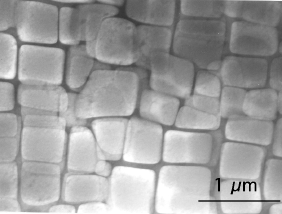Probing the Properties of Materials
Interview with
Ben - We're joined in the studio today by Professor Martin Dove from the School of Physics and Astronomy at Queen Mary University of London. He uses ISIS in his current position and in his previous life as Professor of Computational Mineral Physics in the Department of Earth Sciences at the University of Cambridge. Martin, thank you very much for joining us. We'll get on to how you use ISIS in a moment, but first of all, generally, how do scientists get access to ISIS? How do they apply?
Martin - Every half year, you will write a proposal and then it gets assessed by a panel of your peers, so a standard peer review. That happens as I say every half year and then if you're successful, you get scheduled.
Ben - Is there a quota that we must do this much materials, this much biology, this much basic physics, or is it just that the strongest applications win out?
Martin - It's always the strongest win out, but this is the type of science where people will come along and do shortish experiments - 2, 3, 4 days and there are enough instruments and enough running time that actually, you get the mixture more or less quite naturally I think.
Ben - As Martyn Bull was saying, there's a "village" of different instruments around which means it can do lots of different experiments at the same time.
 Martin - That's right and they're all different types of experiment. Some of them are to look at specifically a structure, some of them are to look at the way atoms move around, and some of them are a mixture.
Martin - That's right and they're all different types of experiment. Some of them are to look at specifically a structure, some of them are to look at the way atoms move around, and some of them are a mixture.
Ben - So, what is it that you currently use ISIS for in your present position at QMUL?
Martin - Well, our big interest is in how the properties of materials are determined by the two aspects that Martyn talked about - where the atoms are and how they move around. We do different sorts of experiments on that. Some of the experiments we do are focused mostly on the structure. In which case, you fire the neutrons in and you measure where they come off, and you then fit a very simple model of the structure. Sometimes you actually do what is called spectroscopy where the neutrons come in and they bounce off with a change in energy and that change in energy is telling you about the energy of the vibrations inside the material.
The other type of experiment, which we've done really quite a lot of lately, is where you attempt to get a series of snapshots where the atoms are at any point in time, and there, you pick up both where they are on average, but actually, how they fluctuate as well, how the atoms are bouncing around. You see both in the same picture and one of the things that we're trying to then do is build atomic models that are then consistent with the data and that tells us a lot about way that the atoms are moving around, and how particularly, the structure departs from its sort of average structure. And that very often tells you something about the way the material behaves.
Ben - So, the answers that we're looking for are to do with the structure and also the dynamics of it. How do we then use those answers to actually tell us something meaningful about the physics of it or at a macro scale as it were?
Martin - Well in the end, macroscopic properties or materials are determined exactly by what goes on at an atomic scale. So, if you look at something like - a range of examples - memory devices where you clearly have a macroscopic magnetism, but that is due entirely to what the atoms are doing. Batteries are another example that we've been working with a group in chemistry here. Batteries consist of an electrolyte material and then things move through them, and you have the end electrodes. Quite where the atoms are going in all that process again is something that neutrons will tell us about and where the atoms are going will determine what the battery properties are.
Ben - So, you're able to look at combinations of materials as well, as well as trying to probe let's say, one homogenous material to understand how that works. In a battery for example, obviously you've got more than one material. Can you look at the interfaces, look at the interactions?
Martin - Yes. Of course, this is where you start to get into a more challenging regime because most experiments, when they were originally devised as an instrument say, would've been thinking about a homogenous sample, but actually, increasing a lot of the challenges had to do with interfaces.
Ben - So, what sorts of things can ISIS show you that you wouldn't be able to get from let's say an electron microscope? We know that electron microscopes can tell you where the atoms are. So, what is it that ISIS gives you that's extra to that?
 Martin - Okay, so you take something like beams of electrons or you take something like beams of x-rays and then you take something like beams of neutrons. They're all looking at something that's fundamentally different in the material. The neutron itself is scattering off of the atomic nucleus whereas x-rays and electrons are interacting with the electrons. So you're picking up a rather different picture. Some materials look invisible to x-rays and look invisible to electrons, some atoms, so hydrogen for example is very difficult to see with x-rays. Actually, it's really is very visible with neutrons. And so, you're getting a different view of the different atoms.
Martin - Okay, so you take something like beams of electrons or you take something like beams of x-rays and then you take something like beams of neutrons. They're all looking at something that's fundamentally different in the material. The neutron itself is scattering off of the atomic nucleus whereas x-rays and electrons are interacting with the electrons. So you're picking up a rather different picture. Some materials look invisible to x-rays and look invisible to electrons, some atoms, so hydrogen for example is very difficult to see with x-rays. Actually, it's really is very visible with neutrons. And so, you're getting a different view of the different atoms.
Ben - So it gives you complementary science to the other science that we're doing.
Martin - Yes, absolutely.
Ben - What sorts of materials have you actually been looking at? You mentioned to me at previous conversation about some very old materials with properties that we just don't expect.
Martin - Usually, most materials when you heat them up will expand, but there are a whole class of materials that we're beginning to uncover that do exactly the opposite. They shrink when you heat them up. It's completely the opposite to the way you'd expect things to be. We also think the same materials do something equally odd which is that when you squash them, they get softer. Most materials, when you squash them, imagine compacting them, it gets harder and harder, but there are some materials that appear to get softer when you squash them. We think they're actually the same material. We did an experiment very recently, only a matter of a few weeks ago to observe this directly. The material actually is a zinc cyanide and we were able, at ISIS, to put it into a high pressure device and that was fantastic because the neutrons are able to see the sample and not see very much of the pressure device so able to pass through all the stuff that makes the high pressure, you get the signal out, and we spent 4 days, 24 hours a day, constantly changing the temperature and the pressure until we got out a picture that showed just how this was behaving and particularly, we're interested in how this was affected by temperature.
Ben - And how do we think it's working?
Martin - Well, it's not really a complicated picture, but it's a rather visual picture. If you think of 3 atoms in a straight line, so A, B and C, and then the one in the middle might usually be an oxygen, something like that. If it rattles up and down, at right angles to this line of atoms, and if that bond of that middle one with the other 2 atoms is stiff, that one going up and down will want the other bonds to stay at a fairly fixed length, and by moving up and down, it pulls the others in. That's kind of the way it works. It's a very visual picture though.
Ben - So it actually sort of pulls them in as if they were springs as it were.
Martin - It pulls them in. It's like they were rods. It's like the bonds are very stiff rods, but the one in the middle is able to flex up and down.
Ben - So we're able to probe some very unusual properties.
Martin - Yes.










Comments
Add a comment